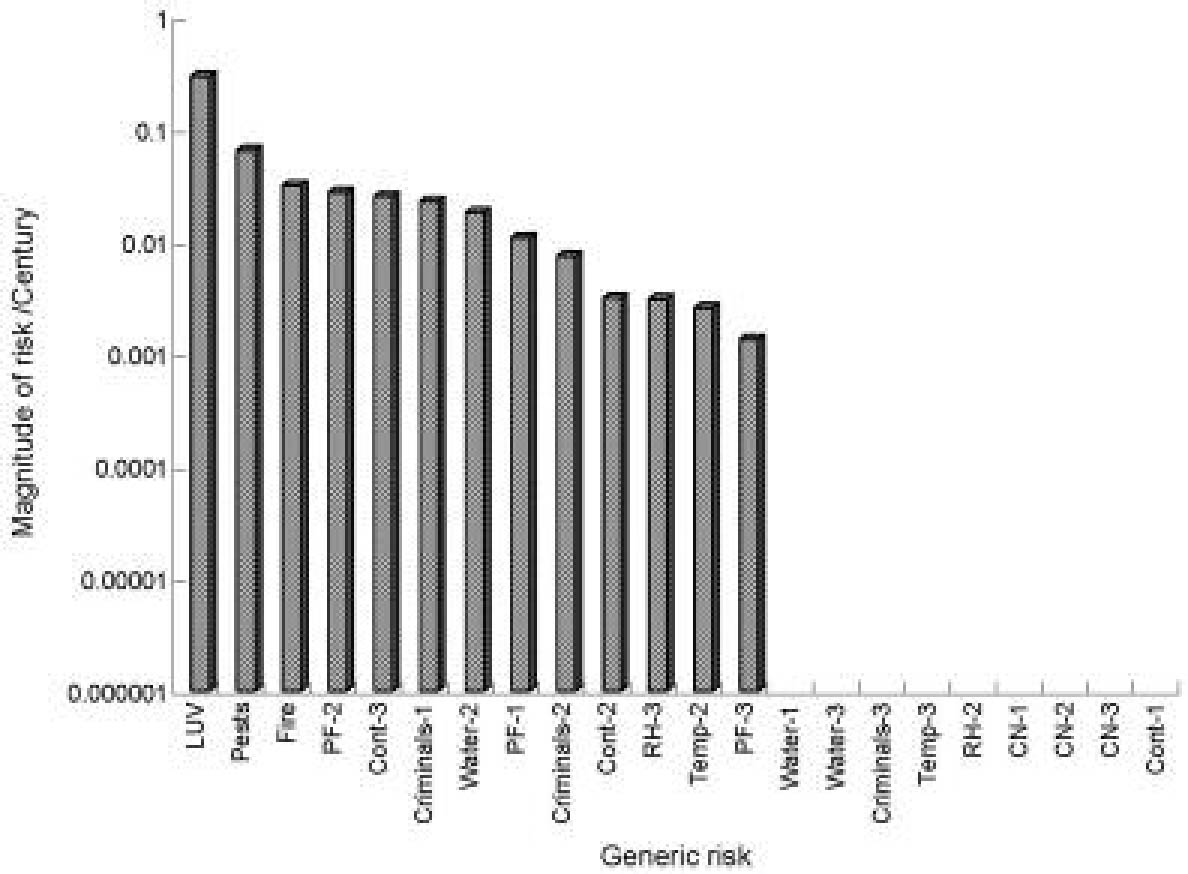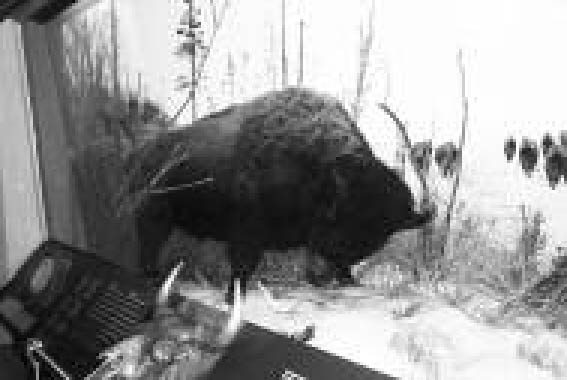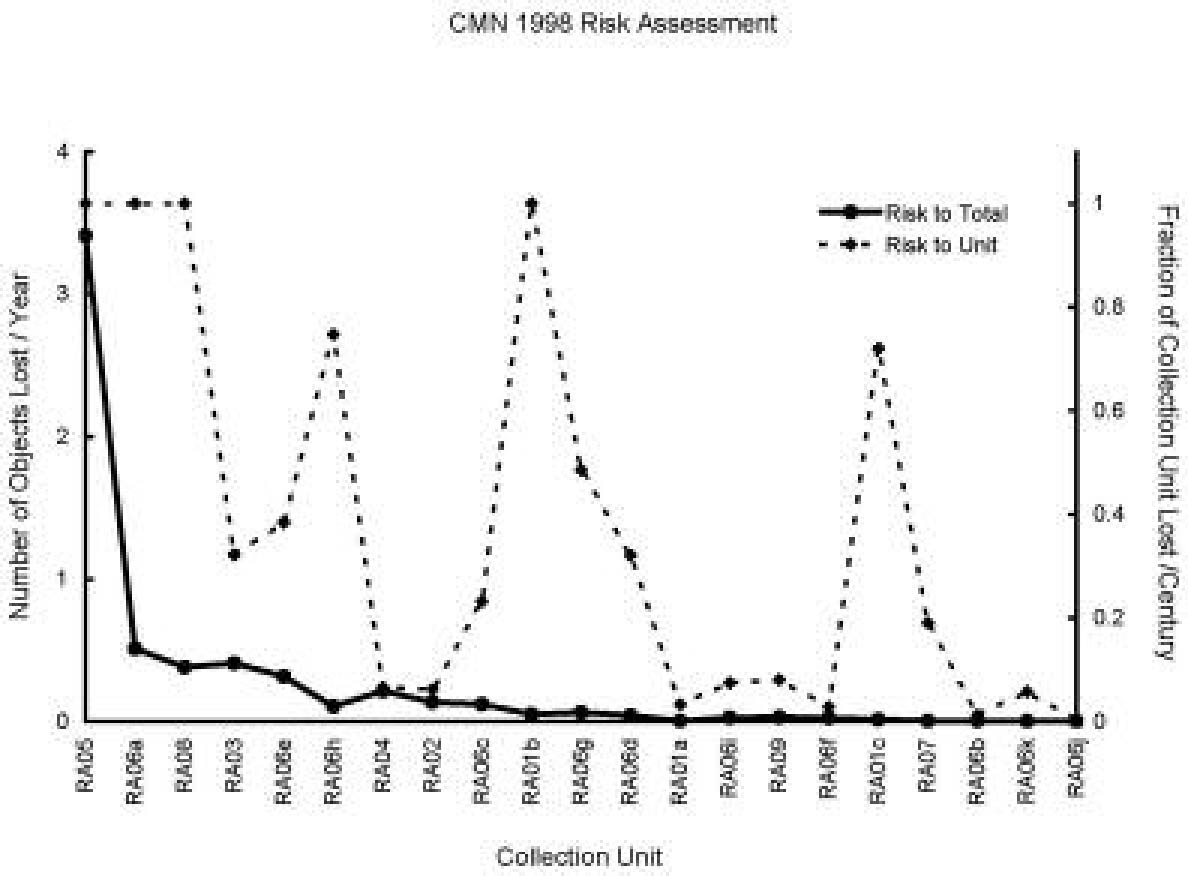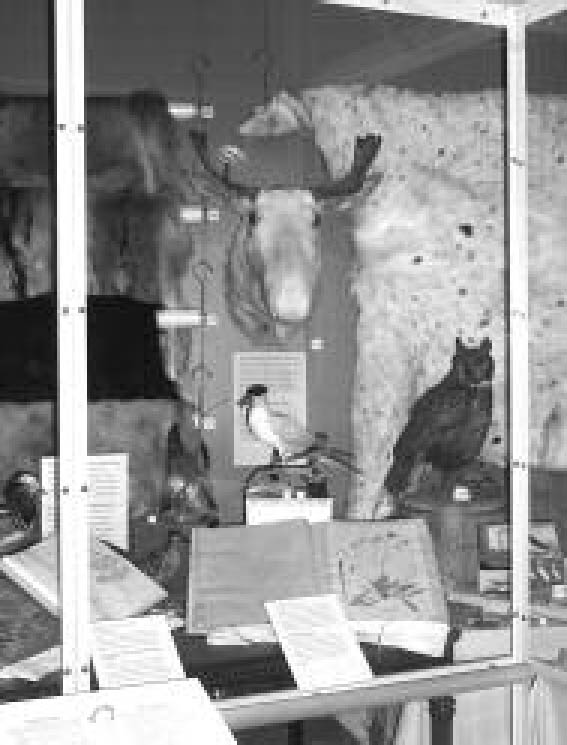RISK ASSESSMENT OF COLLECTIONS IN EXHIBITIONS AT THE CANADIAN MUSEUM OF NATUREGARNET MUETHING, ROBERT WALLER, & FIONA GRAHAM
3 RESULTSThe results of the risk assessment can be organized by specific risk (fig. 2) and by collection unit (fig. 3). This type of graphic representation shows the relative severity of certain risks in comparison to others. Presenting information in this manner is useful when discussing results with staff and management and for presenting results to an audience outside of the museum field. Figure 2 shows the magnitudes of risk to the entire collection of objects on exhibit. Note the logarithmic scale required to depict the great range in magnitude of risk. The highest risk (LUV-light and ultraviolet radiation) is four times greater than the next highest (Pests). Nine of the risks assessed resulted in magnitudes of risk too low to register on the chart. Presenting the results in this manner identifies the most significant risks to the collection in terms of loss of specimens.
Figure 3 shows another method for presenting risk assessment results. This representation shows To further illustrate the logic used in estimating risks, the seven highest risks to the collection in order of severity are described in detail below. 3.1 LIGHT AND ULTRAVIOLET RADIATION
The specific risk assessed was the fading and weakening of specimens caused by exposure to light. The factors influencing the severity of the risk are the sensitivity of specimens, the duration and intensity of the light exposure, and the amount of damage that has already occurred versus the rate of future damage. Specimens susceptible to this damage include taxidermy, skins, plants, insect specimens, plant specimens, and fluid-preserved specimens. The sensitivity of a specimen to value loss depends not only on nominal material sensitivity but also on past exposure, (un)evenness of damage distribution, and effect of the pattern of visual changes in objects on the object values. The greatest uncertainty was often in the last factor. Changes in meaning of objects can be significant even for very subtle visual changes. This risk proved to be more than four times greater than the next highest risk. Considering the visible damage to specimens currently on display at the museum, specifically the taxidermy mounts in dioramas (fig. 4), additional damage is certain to 3.2 PESTSThe specific pest risk determined to be most important was insect pest infestation in exhibits resulting in specimen damage such as chewing, bore holes, etc. The factors influencing the severity of the risk are the known presence of insects in the building, past mitigation efforts such as use of pesticides, and previous and reccurring infestations in exhibits. Specimens susceptible to infestation are taxidermy, skins, plants, and insects. The assessment considered the current level of pest monitoring in the building and the subsequent probability of infestations developing in exhibits.
3.3 FIREThe most significant fire-related specific risk was considered to be a small localized fire resulting in soot deposition on specimens. Factors influencing
Areas of particular concern include open exhibits and displays with poorly sealed cases. Some display areas are glazed on the front and sides to provide a barrier between visitors and specimens, but have no tops (fig. 5). In the event of a fire, soot would readily infiltrate these displays and damage specimens. 3.4 PHYSICAL FORCESThe most significant physical forces specific risk relates to accidents that occur during cleaning, maintenance, or repairs, resulting in physical damage to specimens. Factors influencing the magnitude of this risk include ongoing maintenance, open exhibits (as described under section 3.3 Fire), and an annual cleaning project that brings large numbers of people into close proximity or contact with specimens. All types of specimens are susceptible to this risk to some extent. An important potential accident which contributes to this risk is the dropping of light bulbs while they are being replaced within exhibit cases or above exhibits without closed tops. 3.5 DUSTThe specific risk assessed was dust accumulation on specimens. This risk also considered damage occurring when the dust is removed in the course of normal cleaning maintenance. Some risk assessors might argue that this kind of cleaning erosion should be categorized as a physical forces type 3 risk. It was considered a contaminants type 3 risk here since the main controlling factor is dust accumulation. Factors influencing the severity of this risk include open exhibits and poorly sealed display cases. All types of specimens are susceptible to this risk. 3.6 THEFTThis risk includes professional theft as well as pilfering by individuals with access to exhibit areas. The factors influencing the magnitude of the risk are the accessibility of specimens and the constraints on monitoring large and complex exhibit areas. The most susceptible specimens were determined to be relatively accessible items and those in areas that are difficult to monitor, especially attractive and/or valuable specimens (e.g., gems, fossils, and animal skins). Obscured corners and hidden bays in exhibit areas give security guards a limited view of the space and make monitoring of the entire area difficult. 3.7 WATERThis is the risk of water from roof, plumbing, or sprinkler leaks reaching specimens and resulting in staining, mold, and related damage. Factors include an aging plumbing system, an aging roof, and unsheltered sprinkler heads in galleries. It should be noted that the risk of fire, even with sprinklers, is almost double that of water and that the museum is firmly in favor of having sprinklers in the galleries. Nevertheless, it must be acknowledged that sprinklers contribute to the water-type 2 risk. Most specimens are somewhat susceptible to water damage. 3.8 OTHER ISSUES3.8.1 Relative HumidityDespite the lack of relative humidity controls in the VMMB, the risk of relative humidity damage to collections on display proved to be very low. This was not surprising given that the assessment was looking at the risk to existing objects under existing conditions. For the most part, further humidityrelated damage to items that have been on display for many years is minor. When the museum assesses the risk to specimens that will be put on display in the future, the magnitude of risk for certain collections could be high. Achieving suitable levels of relative humidity in the building therefore remains a priority as the museum seeks to exhibit more of its collection material. 3.8.2 DocumentationThe production of the risk assessment highlighted a number of deficiencies in the museum's documentation system. For example, an absence of condition reports and treatment records made it very difficult to assess the degree of damage that specimens had incurred while on display. In many cases only anecdotal evidence was available. A blue whale vertebra that has been on display in the museum for only five years has a large crack in it. Without documentation of the condition of the specimen before it was put on display there is no way of knowing whether the crack predates display or is display-related damage. |



